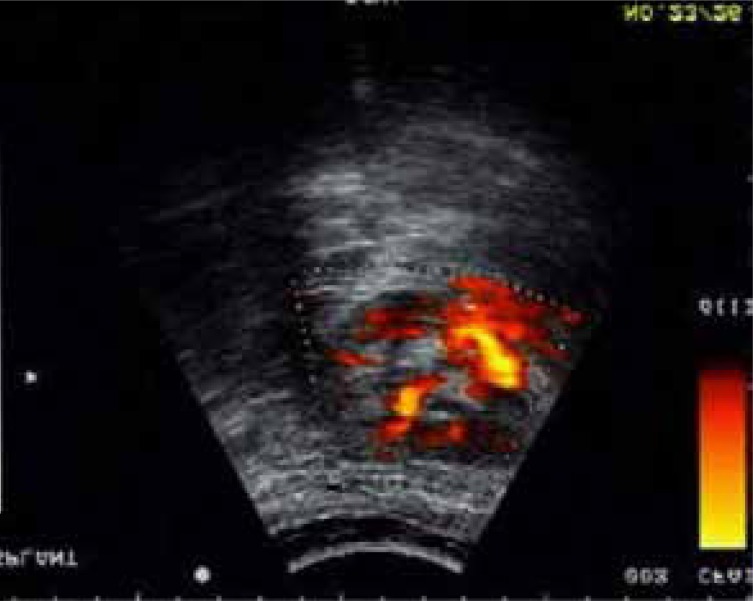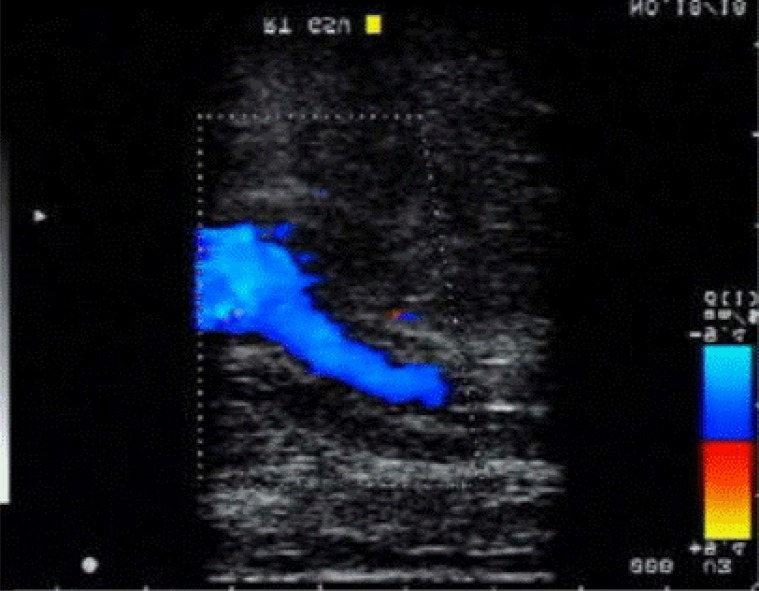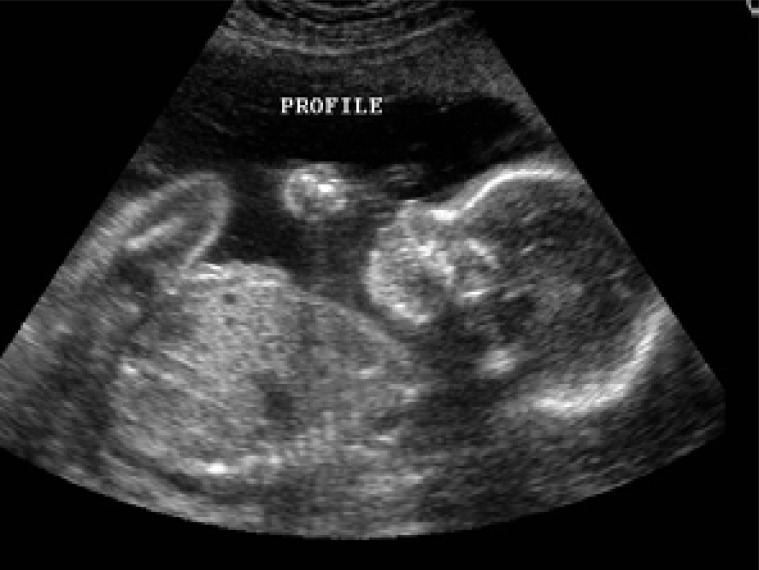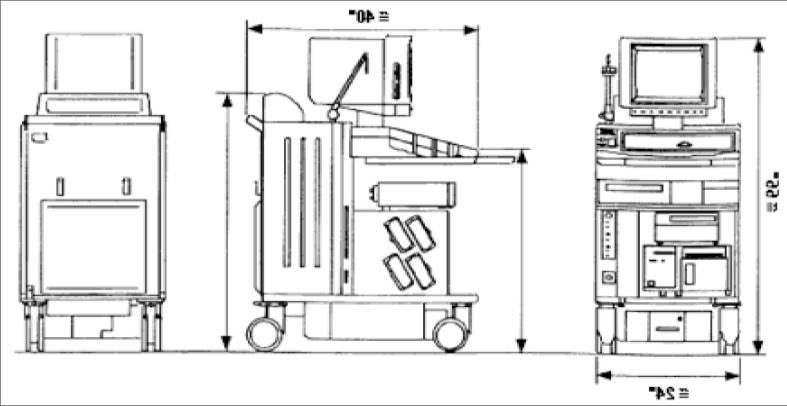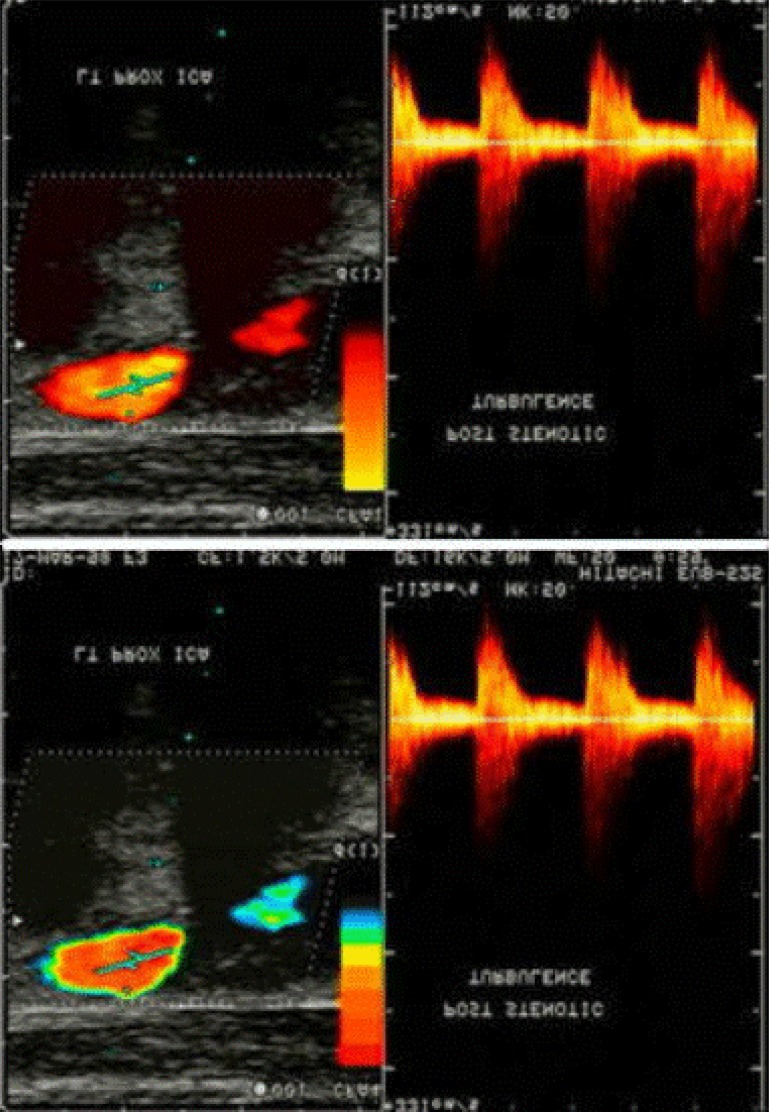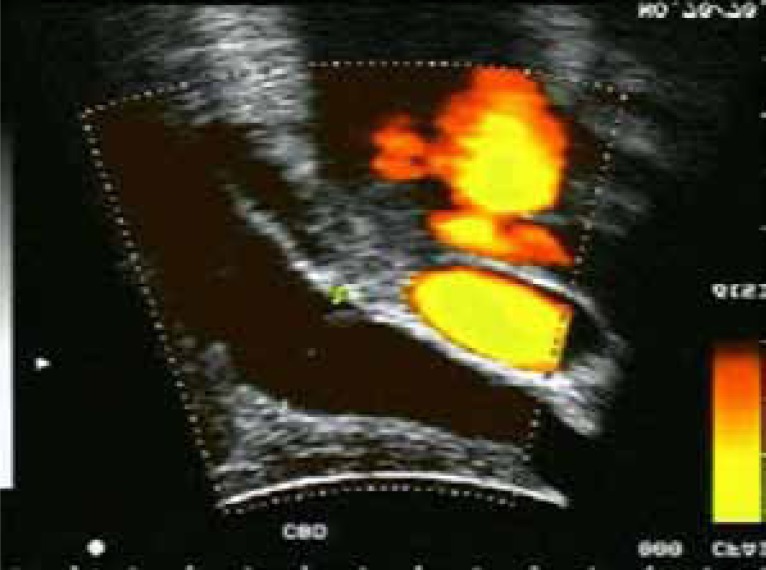Abstract
Ultrasound device, essentially, consists of a transducer, transmitter pulse generator, compensating amplifiers, the control unit for focusing, digital processors and systems for display. It is used in cases of: abdominal, cardiac, maternity, gynecological, urological and cerebrovascular examination, breast examination, and small pieces of tissue as well as in pediatric and operational review.
Key words: medicine, ultrasound.
1. INTRODUCTION
In physics the term “ultrasound” applies to all acoustic energy with a frequency above human hearing (20,000 hertz or 20 kilohertz). Typical diagnostic sonographic scanners operate in the frequency range of 2 to 18 megahertz, hundreds of times greater than the limit of human hearing. Higher frequencies have a correspondingly smaller wavelength, and can be used to make sonograms with smaller details. Diagnostic sonography (ultrasonography) is an ultrasound-based diagnostic imaging technique used to visualize subcutaneous body structures including tendons, muscles, joints, vessels and internal organs for possible pathology or lesions. Sonography is effective for imaging soft tissues of the body. Sonographers typically use a hand-held probe (called a transducer) that is placed directly on and moved over the patient. A water-based gel is used to couple the ultrasound between the transducer and patient (1, 2).
Although discovered 12 years before the X-ray ray (1883.), the ultrasound is a much later found application in medicine. The first practical application of ultrasound is recorded during the World War I in detecting of submarines. The application of ultrasound in medicine began in fifties of last century. First was introduced in the obstetrics, and after that in all the fields of the medicine (the general abdominal diagnostics, the diagnostics in the field of the pelvis, cardiology, ophthalmology and orthopedics and so on) (3). From the clinical aspect the ultrasound possesses the priceless significance because of its noninvasive, good visualization characteristics and relatively easy management (4,5). From the introducing of the processing of the signals of gray scale in 1974 B-mode of the sonography became the widely accepted method. The progress in the forming of the transducers has led to better space resolution and the imaging of very small structures in the abdomen (0.5-1 cm). The development of real-time system led to, even, to the possibility of the continued visualization or the ultrasound fluoroscopy (1). In the ultrasound diagnostics can be differed two techniques (2): transmission and reflection
Transmission technology is based on distinguishing the tissues with different absorbance of ultrasound. Due to uneven absorption of ultrasound images provides internal structure that consists of a mosaic of lighter and darker places. This technology is now abandoned (6,1).
Reflection technology (echo) registers the pulse is reflected from the boundary of two tissues with different acoustic resistance. The technique is based on principle of functioning sonar (“Sonar Navigation and Ranging”). A sound wave is typically produced by a piezoelectric transducer encased in a probe. Strong, short electrical pulses from the ultrasound machine make the transducer ring at the desired frequency. The frequencies can be anywhere between 2 and 18 MHz’s The sound is focused either by the shape of the transducer, a lens in front of the transducer, or a complex set of control pulses from the ultrasound scanner machine. This focusing produces an arc-shaped sound wave from the face of the transducer. The wave travels into the body and comes into focus at a desired depth. Newer technology transducers use phased array techniques to enable the sonographic machine to change the direction and depth of focus. Almost all piezoelectric transducers are made of ceramic (1).
To generate a 2 D-image, the ultrasonic beam is swept. A transducer may be swept mechanically by rotating or swinging. Or a 1D phased array transducer may be use to sweep the beam electronically. The received data is processed and used to construct the image. The image is then a 2D representation of the slice into the body. 3D images can be generated by acquiring a series of adjacent 2D images. Commonly a specialized probe that mechanically scans a conventional 2Dimage transducer is used. However, since the mechanical scanning is slow, it is difficult to make 3D images of moving tissues. Recently, 2D phased array transducers that can sweep the beam in 3D have been developed. These can image faster and can even be used to make live 3D images of a beating heart.
Four different modes of ultrasound are used in medical imaging (1, 3).
These are:
A-mode: A-mode is the simplest type of ultrasound. A single transducer scans a line through the body with the echoes plotted on screen as a function of depth. Therapeutic ultrasound aimed at a specific tumor or calculus is also A-mode, to allow for pinpoint accurate focus of the destructive wave energy.
B-mode: In B-mode ultrasound, a linear array of transducers simultaneously scans a plane through the body that can be viewed as a two-dimensional image on screen.
M-mode: M stands for motion. In m-mode a rapid sequence of B-mode scans whose images follow each other in sequence on screen enables doctors to see and measure range of motion, as the organ boundaries that produce reflections move relative to the probe.
Doppler mode: This mode makes use of the Doppler effect in measuring and visualizing blood flow. Doppler sonography play important role in medicine. Sonography can be enhanced with Doppler measurements, which employ the Doppler effect to assess whether structures (usually blood) are moving towards or away from the probe, and its relative velocity. By calculating the frequency shift of a particular sample volume, for example a jet of blood flow over a heart valve, its speed and direction can be determined and visualized. This is particularly useful in cardiovascular studies (sonography of the vasculature system and heart) and essential in many areas such as determining reverse blood flow in the liver vasculature in portal hypertension (6,7). The Doppler information is displayed graphically using spectral Doppler, or as an image using color Doppler (directional Doppler) or power Doppler (non directional Doppler). This Doppler shift falls in the audible range and is often presented audibly using stereo speakers: this produces a very distinctive, although synthetic, pulsing sound (8).
The transoesophageal echo cardiography (TEE) opened the window in the diagnostic imaging in the field of the cardiography, card surgery and anesthesia. Using TEE in 2-D mode, the anesthesiologist can monitor the heart movements, and cardiac surgeon will become the valuable information about the heart condition after the critical surgical procedure.
2. THE NATURE OF ULTRASOUND
Ultrasonic waves are waves of frequency above the audible frequencies the human ear. In medical diagnostics are used ultrasound frequencies between 3 and 10 MHz.
The most important parameters describing the wave are (1):
Wavelength
Frequency
Velocity
Intensity
The first three characteristics are linked together by the formula:
v = fl
v–Velocity of ultrasound (approximately 1540 m/s in the soft tissues),
f–Frequency in Hz
l–Wavelength in m
In medical ultrasound diagnostics are used short pulses of ultrasound, which contain a whole range of frequencies. Human tissues are not homogeneous in terms of the ultrasonic waves, and the passage of waves through the tissue leads to refraction, reflection, scattering and absorption of energy.
Reflection depends on the characteristic acoustic impedance of the funds on whose border is reflected ultrasound. The absorption and refraction of ultrasound increases with frequency, i.e., lower frequencies are pervasive. Therefore, for abdominal examinations (liver, kidneys, pancreas) using a frequency of about 3 MHz, for examination of children, neck, breast, and the similar–around 5 MHz, and some times even 7 MHz. The higher frequency allows better discernment of detail in the picture, and is being used by the highest frequencies that are sufficiently pervasive.
3. DOPPLER EFFECT
This phenomenon consists in the fact that the receiver, which is moving relative to the inverter, receives a different frequency than emitted. If the receiver and transmitter are closer to the frequency received by the receiver is higher than transmitted, and if you move away, received frequency is lower. Difference transmitted and received frequency is called Doppler shift (2).
With the use of ultrasound in medicine inside the body to emit short pulses of ultrasound (duration less than one microsecond) and detects their echoes from inside the body.
4. THE MAIN COMPONENTS OF THE ULTRASONIC DEVICES
Ultrasound device, essentially, consists of a transducer, transmitter pulse generator, compensating amplifiers, the control unit for focusing, digital processors and systems for display.
It is used in cases of: abdominal, cardiac, maternity, gynecological, urological, cerebrovascular examination, breast examination, and small pieces of tissue as well as in pediatric and operational review.
5. THE INVERTER AND THE ULTRASOUND BEAM
The inverter is a device that converts electrical signals into mechanical (ultrasonic vibrations), and vice versa. When activated inverter is leaned on the body, it emits an ultrasonic beam. Ultrasonic waves are focused by lenses, ultrasonic mirrors and by electronic means 1, 4, 5).
6. ULTRASONIC TRANSDUCERS
Medical ultrasound transducer (echo scopic probe is a device that is placed on the patient’s body and contains one or more ultrasonic transducers (6, 7, 8).
We can distinguish:
Linear probe
Sectoral probe
Probe, in which the ring changer focusing is performed
Rocking mirror test
Convex probe
Linear can be used at all locations where an access “window” into the body is large enough. In tests of shallow bodies of interference in an area near the transducer (near field) is negatively affecting the image quality, so should be used the “spacing path” (the layer of water or gel). Since it is important for thee diagnosis that the same reflectors appear as equals in the image, attenuation must be compensated electronically. Compensatory amplifier further enhances the echoes from deeper structures than those of shallow. If the tissue is more absorbent, it must be the differences of front and rear of echo do more. The stronger echo appears as brighter and with less dark spots. Figure rope dynamics of the contrasts and more suitable for geometric measurements. Doppler Effect is used to measure the velocity of blood flow in several ways. If the ultrasound emitted continuously, the system measures measure all speeds, but without depth resolution.If the pulses are used, then we have the depth resolution (we can choose the depth of blood vessels), but the possible large errors in the measurement of high-speed deep into the body.
Flow towards the probe is shown as shades of red, a flow rate of the probe in shades of blue. This system greatly speeds up the orientation in the flow measurement
7. SOME PROBLEMS IN THE USE OF ULTRASONIC DEVICES
Important role in the detail and accuracy of ultrasound plays a distinguishing details. Discrimination of an ultrasonic device can be defined as the minimum distance of two reflectors in the body that is on the screen can be recognized as separate.
Resolution can be divided into:
Lateral (sideways)
Axial (depth)
Lateral resolution depends on the thickness of the beam. At higher frequencies it is easier to achieve narrow beam, but the penetration is reduced.
In examination of the children are used frequency 5-7 MHz, while in adults 3-5 MHz. If we work with the reduced sensitivity of the device, then the weak reflectors (parenchyma) lose the pictures, but the lateral resolution for the remaining, stronger, reflectors is better.
Axial resolution is much better than regular lateral also for display of thin structures (e.g. thin blood vessels) the probe should be always oriented to the vessels so that blood flow across the ultrasound beam.
At present conventional ultrasonic device to create images we are using only the amplitude (intensity) response.
Figure 1.
Data flow in an artery of transplanted kidneys – B mode
Figure 2.
Doppler Effect in the observation of vein–M mode
Figure 3.
Display of the fetus in uterus
Figure 4.
Ultrasonic device
Figure 5.
Presentation of stenosis and jet in main artery of the neck–M mode
Figure 6.
Display of cervical artery with calcification present in the wall-M mode
Figure 7.
View inside the abdominal cavity–B mode
REFERENCES
- 1.Masic I, Ridjanovic Z, Pandza H, Masic I. Sarajevo: Avicena; 2010. Medical informatics; pp. 416–430. [Google Scholar]
- 2.Pericic V, Glicic Lj. Dijagnostika bolesnika gornjega abdomena ultrazvukom. U: Dijagnostika i diferencijalna dijagnostika u gastroenterologiji i hepatologiji. Urednici: Pericic V, Glicic Lj. Zajecar, Zajecar-Beograd. 1981. pp. 329–37.
- 3.Bijelic J, Cocic M, et al. Savremena dostignuca u tehnici i medicinskoj dijagnostici u gastroenterologiji. U: Prvo jugoslovensko savetovanje “Tehnikaimedicina”, održano u Beogradu 1985. godine, zbornik radova, knjiga I, Beograd. 1985. pp. 41–70.
- 4.Palmer R. Bar Code and scanning technology in the health care industry. Intermec Co. 1988. Feb 16,
- 5.Markovic N, Slavkovic Z, et al. Primena nekih savremenih tehnickih dostignuca u anesteziji i reanimaciji. U: Prvo jugoslovensko savetovanje “Tehnikaimedicina”, održano u Beogradu, 1985. godine, zbornik referata, knjiga I, Beograd. 1985. pp. 34–40.
- 6.Ivancic D. Uloga informatickih metoda u suvremenom klinickom radu. Lijec Vjesn. 1987;109:468–71. [PubMed] [Google Scholar]
- 7.Salihefendic N, Zildzic M, Licanin Z, Muminhodzic K, Zerem E, Masic I. :101–130. [Google Scholar]
- 8.Masic I, Ridjanoci Z. Sarajevo: Avicena. Sarajevo; 1999. Medicinska informatika; pp. 193–244. [Google Scholar]



